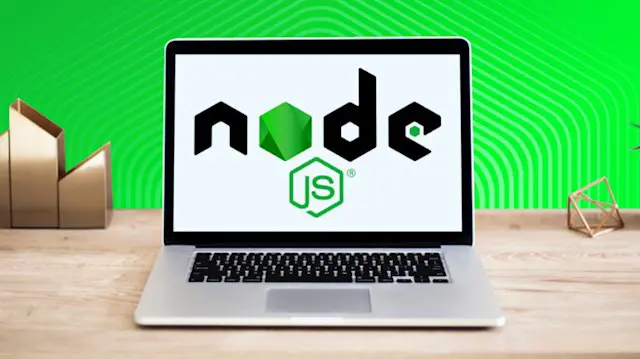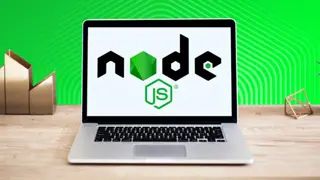
NodeJS For Beginners
Nodejs in Javascript, learn rapidly growing web server technology, Nodejs & understand how NodeJS works with Node course
Oak Academy
Summary
- Reed courses certificate of completion - Free
Add to basket or enquire
Overview
Hello there,
Welcome to NodeJS For Beginners course.
Node js in Javascript, learn rapidly growing web server technology, Nodejs & understand how NodeJS works with Node course
Node.js is an open-source, cross-platform, back-end, JavaScript runtime environment that executes JavaScript code outside a web browser. Nodejs, node js, node, node.js, nodejs beginner, node js for beginners, node.js for beginners, node js beginner, nodejs for beginners, learn and understand nodejs, node js beginners, node beginner
By learning growing web server technology, NodeJS, you can improve your skills, get a new job and you can build powerful, robust web applications.
What Node.JS can do?
-
Nodejs can generate the dynamic page content
-
Nodejs can create, open, read, write, delete, and close files on the server
-
Nodejs can collect form data
-
Nodejs can add, delete, modify data in your database
This course is designed to be a comprehensive approach to Node JS. It is really easy to learn Node JS. That is being said, no prior knowledge or experience is required. At the end of this course, you will get the basics of Node JS.
In this course, we'll look at how the C++ written V8 Javascript engine works and how NodeJS uses it to expand the abilities of Javascript.
Node.js is essential to developing real-time applications in JavaScript and has been instrumental in the development of websites like eBay and PayPal. Node is designed around an event loop, which allows for easy management of asynchronous functions. This makes it a popular environment for modern developers working on chat and gaming apps.
In this course;
You'll learn how asynchronous code works in Node and the Node event loop, as well as how to use the event emitter, streams, buffers, pipes, and work with files. We'll see how that leads to building a web server in Node with hands-on examples.
With my Node JS course, you will learn rapidly growing web server technology, and become a Node developer which is among the highest-paid in the industry.
What is Node.Js and what is it used for?
Node.Js is a server environment built for fast and easily scalable network applications. It was built on Chrome’s JavaScript runtime and uses an event-driven, non-blocking model that makes it the best fit for applications that run on distributed devices and need to run in real-time. By using JavaScript, node.Js can be put to work by many software developers familiar with JavaScript. Because the code is open-source, you can also use it on any platform (Mac OS, Windows, or Linux). Node.js is the architecture for creating websites and real-time applications because it’s easy for teams to learn, and it’s fast. Examples of applications that use node.Js include video conferencing apps, chat servers, eCommerce software, and collaborative online gaming.
What are the advantages of Node.Js?
Node.Js is open-source, meaning it’s a free code for all developers. On top of that, it also means that there is a thriving community of Node.Js users and programmers that all add to the knowledge base. Many are happy to share their flavor of the code with other developers, and collectively, the Node.Js environment continues to be enhanced. Because Node.Js uses JavaScript, there is a large pool of developers that understand and can code in the environment. It’s also a relatively simple environment for new team members to learn, making it an efficient choice for development teams with people that need training. Node.Js was developed on Push technology instead of web sockets, which is why it’s the preferred choice for real-time communication applications and programs that need to be highly scalable.
What does it mean that Node.Js is a runtime system?
A runtime system is a platform where a software program runs. It’s essentially an environment housing the collection of software and hardware that allows an application to execute (or run). Node.Js is a runtime system because it provides the environment necessary for applications to run within it, and no additional code or hardware is required. Because Node.Js makes use of JavaScript, it’s a runtime system that provides a framework where you can use JavaScript to create and run programs. The JavaScript programming language (which is quite popular) is then automatically translated into machine code for the hardware to run the program in real-time. It’s an efficient system, making it the preferred choice for many software and tech companies.
You'll also get:
-
Lifetime Access to The Course
-
Fast & Friendly Support in the Q&A section
Dive in now NodeJS For Beginners course
We offer full support, answering any questions.
See you in the course!
Curriculum
Course media
Description
Hello there,
Welcome to NodeJS For Beginners course.
Node js in Javascript, learn rapidly growing web server technology, Nodejs & understand how NodeJS works with Node course
Node.js is an open-source, cross-platform, back-end, JavaScript runtime environment that executes JavaScript code outside a web browser. Nodejs, node js, node, node.js, nodejs beginner, node js for beginners, node.js for beginners, node js beginner, nodejs for beginners, learn and understand nodejs, node js beginners, node beginner
By learning growing web server technology, NodeJS, you can improve your skills, get a new job and you can build powerful, robust web applications.
What Node.JS can do?
-
Nodejs can generate the dynamic page content
-
Nodejs can create, open, read, write, delete, and close files on the server
-
Nodejs can collect form data
-
Nodejs can add, delete, modify data in your database
This course is designed to be a comprehensive approach to Node JS. It is really easy to learn Node JS. That is being said, no prior knowledge or experience is required. At the end of this course, you will get the basics of Node JS.
In this course, we'll look at how the C++ written V8 Javascript engine works and how NodeJS uses it to expand the abilities of Javascript.
Node.js is essential to developing real-time applications in JavaScript and has been instrumental in the development of websites like eBay and PayPal. Node is designed around an event loop, which allows for easy management of asynchronous functions. This makes it a popular environment for modern developers working on chat and gaming apps.
In this course;
You'll learn how asynchronous code works in Node and the Node event loop, as well as how to use the event emitter, streams, buffers, pipes, and work with files. We'll see how that leads to building a web server in Node with hands-on examples.
With my Node JS course, you will learn rapidly growing web server technology, and become a Node developer which is among the highest-paid in the industry.
What is Node.Js and what is it used for?
Node.Js is a server environment built for fast and easily scalable network applications. It was built on Chrome’s JavaScript runtime and uses an event-driven, non-blocking model that makes it the best fit for applications that run on distributed devices and need to run in real-time. By using JavaScript, node.Js can be put to work by many software developers familiar with JavaScript. Because the code is open-source, you can also use it on any platform (Mac OS, Windows, or Linux). Node.js is the architecture for creating websites and real-time applications because it’s easy for teams to learn, and it’s fast. Examples of applications that use node.Js include video conferencing apps, chat servers, eCommerce software, and collaborative online gaming.
What are the advantages of Node.Js?
Node.Js is open-source, meaning it’s a free code for all developers. On top of that, it also means that there is a thriving community of Node.Js users and programmers that all add to the knowledge base. Many are happy to share their flavor of the code with other developers, and collectively, the Node.Js environment continues to be enhanced. Because Node.Js uses JavaScript, there is a large pool of developers that understand and can code in the environment. It’s also a relatively simple environment for new team members to learn, making it an efficient choice for development teams with people that need training. Node.Js was developed on Push technology instead of web sockets, which is why it’s the preferred choice for real-time communication applications and programs that need to be highly scalable.
What does it mean that Node.Js is a runtime system?
A runtime system is a platform where a software program runs. It’s essentially an environment housing the collection of software and hardware that allows an application to execute (or run). Node.Js is a runtime system because it provides the environment necessary for applications to run within it, and no additional code or hardware is required. Because Node.Js makes use of JavaScript, it’s a runtime system that provides a framework where you can use JavaScript to create and run programs. The JavaScript programming language (which is quite popular) is then automatically translated into machine code for the hardware to run the program in real-time. It’s an efficient system, making it the preferred choice for many software and tech companies.
What is microservices architecture and how can Node.Js be used for it?
Microservices architecture is a software development style or method where single-function modules originate. Each has a very well-defined operation and interface and can deploy on its own. In essence, it’s a way of developing modules that you can repurpose from one program or application to another. When you create an application, it’s a collection of modules that have been thoroughly tested and are well-maintained. The modules are typically built around different business-specific capabilities and are then loosely coupled to other modules when deployed as part of a program. You can use Node.Js in microservices architecture as the language of choice for one, some, or all of the microservices (or modules). The beauty of microservices is that you can use the best language for the specific microservice. But where highly scalable, fast programs are needed, Node.Js would be a top contender.
You'll also get:
-
Lifetime Access to The Course
-
Fast & Friendly Support in the Q&A section
Dive in now NodeJS For Beginners course
We offer full support, answering any questions.
See you in the course!
Who is this course for?
- Anyone looking to build a career as a NodeJS developer
- Anyone interested in NodeJS
- Developers new to NodeJS
Requirements
- Ability to install software on your computer
- Basic HTML knowledge
- Basic understanding of JavaScript
- Desire to learn NodeJS, Node, Node JS
- Nothing else! It’s just you, your computer and your ambition to get started today
- LIFETIME ACCESS, course updates, new content, anytime, anywhere, on any device.
Questions and answers
Currently there are no Q&As for this course. Be the first to ask a question.
Certificates
Reed courses certificate of completion
Digital certificate - Included
Will be downloadable when all lectures have been completed
Reviews
Currently there are no reviews for this course. Be the first to leave a review.
Legal information
This course is advertised on reed.co.uk by the Course Provider, whose terms and conditions apply. Purchases are made directly from the Course Provider, and as such, content and materials are supplied by the Course Provider directly. Reed is acting as agent and not reseller in relation to this course. Reed's only responsibility is to facilitate your payment for the course. It is your responsibility to review and agree to the Course Provider's terms and conditions and satisfy yourself as to the suitability of the course you intend to purchase. Reed will not have any responsibility for the content of the course and/or associated materials.


